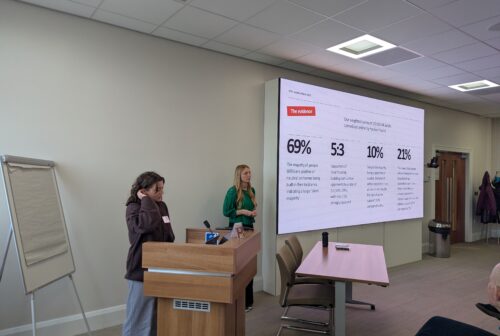RTPI: Healthy Places Conference

Social Impact Lead Ruth Skidmore and Account Executive Ailsa Rhodes spent the morning in Preston at the RTPI Healthy Places Conference, exploring a deceptively simple question: what makes a healthy place?
The conversations made one thing clear: planning is a public health intervention that must be better used to shape our country’s health. Planning has the power to define how we live, age and thrive.
But if planning can do all this, how do we make it happen? The answer that emerged throughout the day was collaboration between planners, developers, health professionals, local authorities and communities. Healthy places aren’t created in isolation; they are the product of partnership.
Planning and health: a shared responsibility
The event opened with Steve Benge, Population Health Intelligence Advisor at West Lancashire Borough Council, who shared striking research on the impact placemaking has on health. Beyond the obvious benefits of green space and active travel, Steve highlighted that planning decisions influence almost every aspect of wellbeing. Linking his points to the UN Sustainable Development Goals, he reminded us that housing, transport and community design are all critical tools for reducing health inequalities.
Borrowing the words of Chris Whitty, Steve ended on an inspirational note: “More has been done for public health by proper planning than almost any other intervention (except, perhaps, vaccination).” It was a powerful reminder that the built environment is as critical to public health as hospitals and clinics. To achieve this, planners and health professionals must actively collaborate to share knowledge and data.
Designing homes for healthier ageing
Andrew Atkinson of Fairhaven Homes used his experience as a provider of supported living to continue the theme of health and placemaking. As our population ages, the housing market needs to reflect this reality, making it crucial to provide homes tailored to specific needs.
Andrew called for local plans to go further by designating space for age-appropriate housing, recognising that older people’s health outcomes improve significantly when they live in homes suited to their needs.
Delivering these specialist homes isn’t just good for residents; it benefits the wider system. If specialist providers like Fairhaven take the lead, it eases pressure on other developers to focus on equally essential housing types, such as family homes and affordable housing. Partnership across the sector creates a balanced mix that works for everyone.
Aligning local voices with national trends
But what happens when local concern clashes with national trends?
As community engagement specialists, we often hear contradictory requests from communities – classically, the need to supply school spaces for children, while also needing to supply bungalows and accessible homes for aging community members.
However, demographic trends provide a key to unlocking these conversations. The Department for Education expects the number of pupils in state schools to decline by 400,000 over the next decade, while the population of pensionable age will increase by 1.7million.
This is why collaboration matters. We need to create spaces for informed dialogue, helping communities understand the journey of a development and educating them on the needs of the population. Collaboration between planners, health professionals, education providers, and communities is essential to anticipate tomorrow’s needs and design places that work for everyone. Planners must go beyond reacting to today’s concern, planners should be empowered to shape healthy, sustainable futures.
But informed dialogue requires us to understand what truly motivates our communities and decision-makers. It requires moving beyond pure statistics to grasp the real-world value of development.
Stories behind the data
In the workshop run by our own Ruth and Ailsa, we asked attendees: “Do you see most value in stories or monetisation during planning?” and “Where have you seen social impact in the built environment?”
The responses reinforced the foundational theme: successful placemaking requires joined-up thinking. Planners, developers, and health professionals need to work together to create places that genuinely support wellbeing. Crucially, the greatest strength lies in combining rigorous data with real, lived experience. On that point, we all agreed: real stories matter. When advocating for housing that promotes health, data is essential, but lived experience brings the message home.
Across the country we’ve been asking people what their home means to them. For delegates at the conference their house means; family, proximity, a safe space and a shelter, warmth, raising children, privacy, a space that reflects personal character, independence from living with parents, a space to work on mental health, rest, fundamental to wellbeing and a place to be proud of.
Collaboration as the foundation
Perhaps then, the underlying theme of the event was the importance of collaboration. Whether that’s between planners and healthcare professionals, local authorities and care service providers, or developers and community groups, partnership is the foundation of healthy placemaking.
For those of us working in planning and development, these discussions reinforce a simple truth that every decision we make about place has a ripple effect on health. Embedding this thinking is the essential groundwork for a healthier, more sustainable future.
